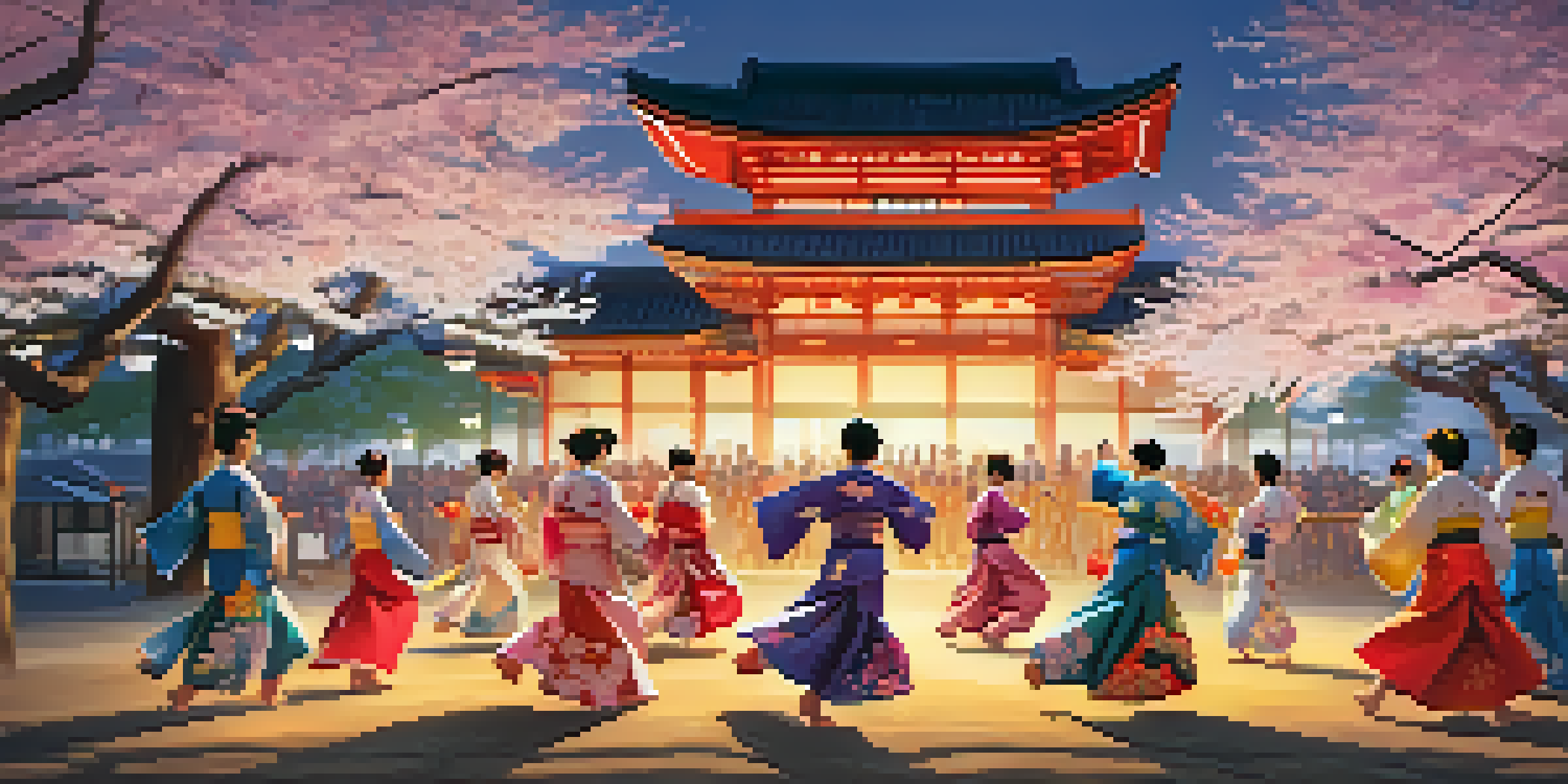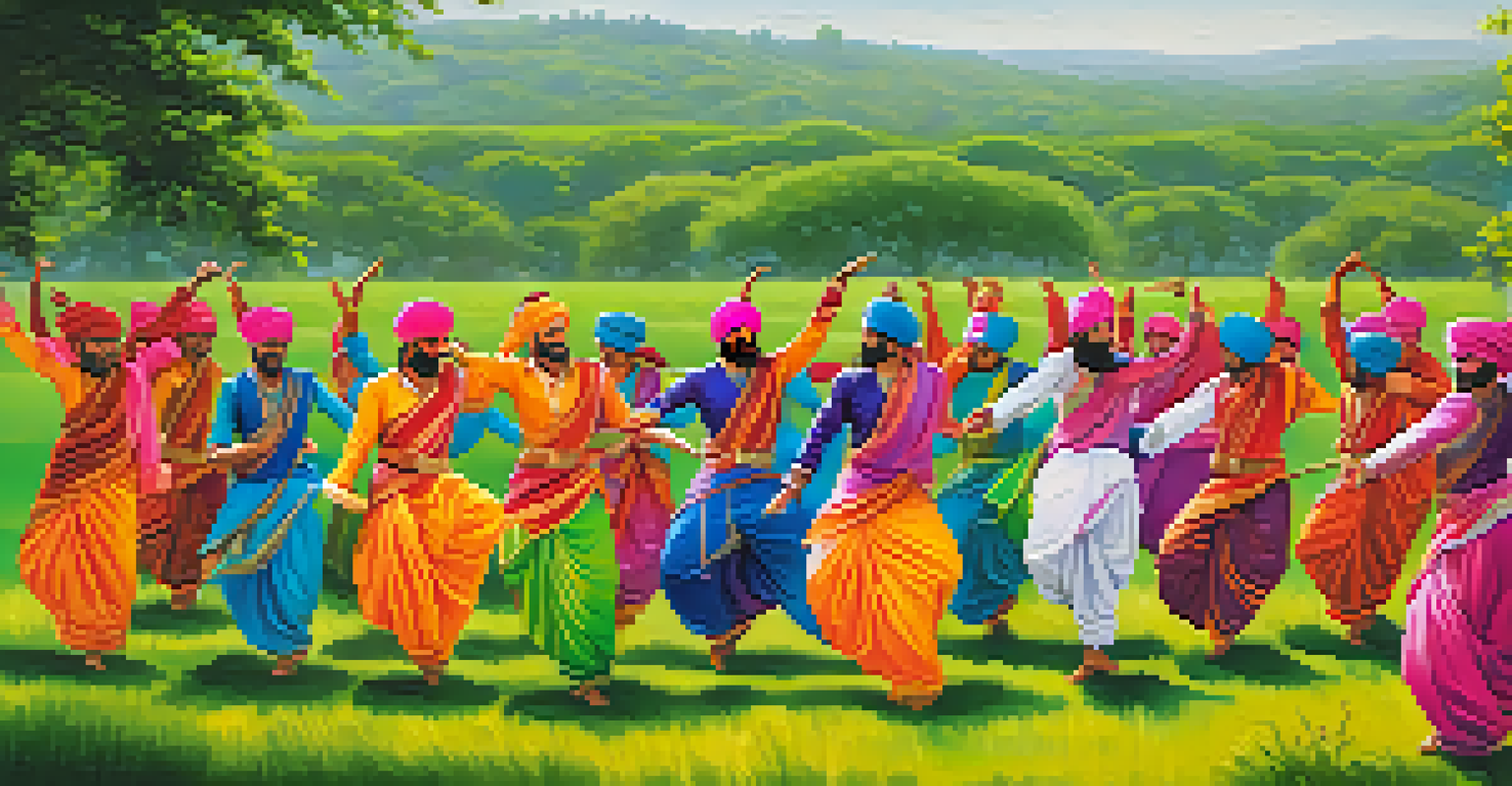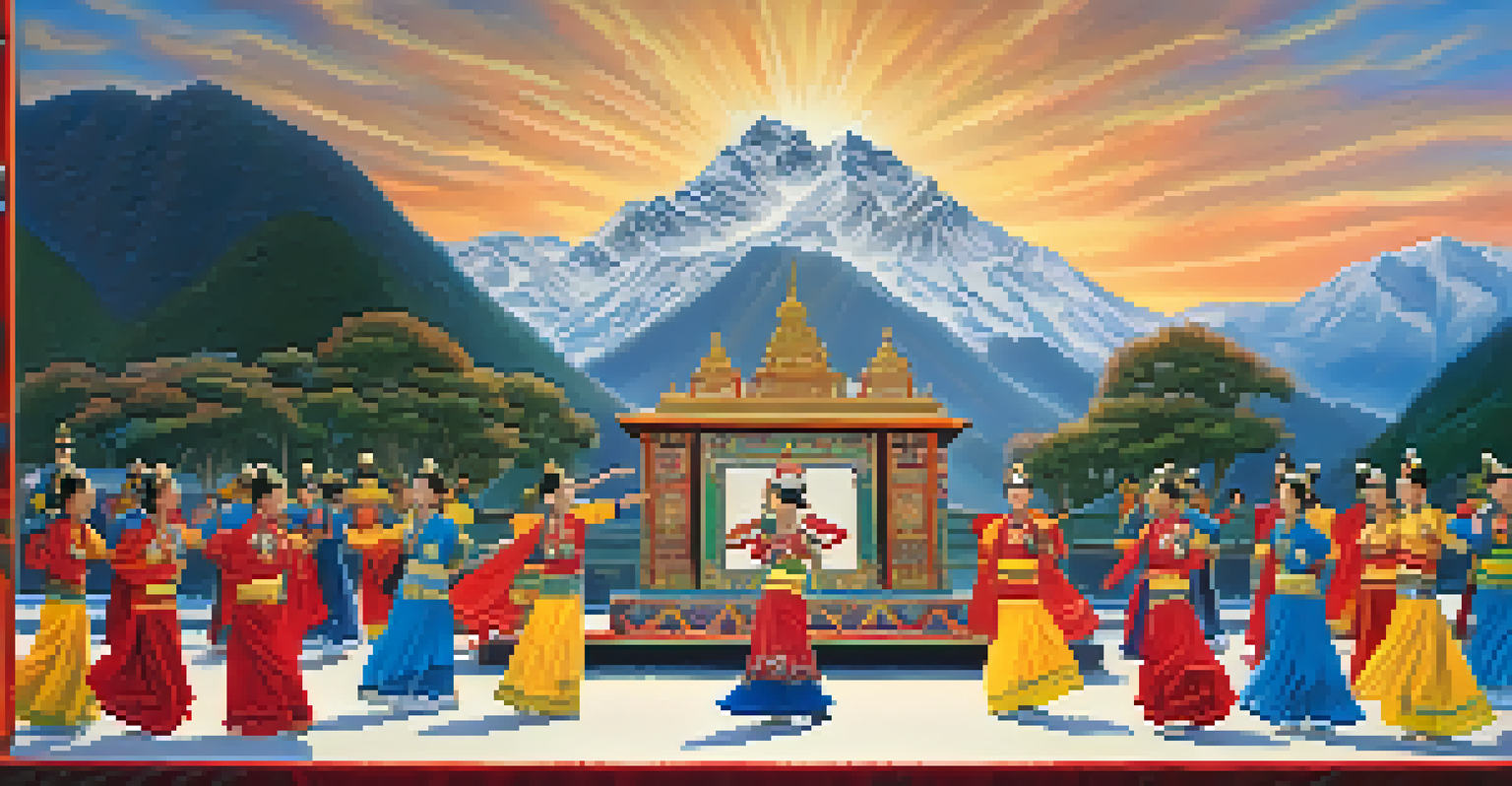Asian Folk Dance: A Tapestry of Traditions and Stories

Understanding the Essence of Asian Folk Dance
Asian folk dance is more than just movement; it's a vibrant tapestry of culture, tradition, and storytelling. Each dance form serves as a window into the history and beliefs of the communities from which it originates. By observing these dances, one can sense the deep-rooted connections to nature, spirituality, and daily life that define many Asian cultures.
Dance is the hidden language of the soul.
From the graceful movements of the Japanese Bon Odori to the lively steps of the Indian Bhangra, each dance tells a unique story. These performances often reflect agricultural cycles, seasonal changes, or significant life events, showcasing the community's values and experiences. It's fascinating how a single dance can encapsulate centuries of history in just a few minutes of performance.
As we delve deeper into specific styles, we begin to appreciate the intricate details that make each one unique. The costumes, music, and choreography all play essential roles in creating an authentic representation of cultural identity, making folk dance an important part of preserving heritage.
The Role of Music in Asian Folk Dance
Music is the heartbeat of Asian folk dance, providing rhythm and emotion that guide the movements. Traditional instruments, such as the Chinese erhu or the Indian tabla, create sounds that resonate with the dancers and the audience alike. This synergy between music and dance transforms a performance into an immersive experience that captivates the senses.

Each region has its own musical style that complements its folk dances. For instance, the lively beats of the Filipino Tinikling are paired with bamboo clappers, while the haunting melodies of the Tibetan dances evoke a sense of spirituality. This connection between sound and movement not only enhances the aesthetic but also strengthens cultural identity.
Folk Dance: A Cultural Tapestry
Asian folk dance serves as a vibrant expression of cultural identity, storytelling, and community values.
Moreover, music often carries its own stories, sometimes even predating the dances themselves. Many songs are passed down through generations, preserving the narratives of ancestors and community legends, which adds another layer of depth to the dance experience.
Diversity of Asian Folk Dance Styles
Asia is a continent rich in diversity, and this is beautifully reflected in its folk dance styles. From the energetic Lion Dance of China, performed during Lunar New Year festivities, to the serene and meditative movements of Tibetan dance, each form offers a glimpse into the region’s cultural fabric. These dances vary not just in style but also in purpose and meaning.
The dance is a poem of which each movement is a word.
In India alone, there are numerous folk dance forms, each tied to different states and communities, such as the Garba from Gujarat or the Kathakali from Kerala. Similarly, in Southeast Asia, the Balinese Legong dance channels the stories of ancient epics, showcasing a blend of drama and artistry. This variety illustrates how folk dance serves as both entertainment and a means of cultural expression.
As we explore these diverse styles, we begin to see how they all share common themes of celebration, storytelling, and connection to the earth and community. This rich assortment of dances is a testament to the creativity and resilience of the people across Asia.
The Significance of Costumes in Folk Dance
Costumes in Asian folk dance are more than just attire; they are vibrant expressions of cultural identity and artistic creativity. Each costume is carefully crafted to reflect the traditions of the community, often using colors, patterns, and materials that have symbolic meanings. For instance, the elaborate headdresses of Thai dancers signify status and cultural heritage.
The choice of fabric and design can also tell stories about the region's history and resources. In many cases, costumes are handcrafted by local artisans, ensuring that the traditions and skills are passed down through generations. This connection to craftsmanship adds a layer of cultural significance to each performance.
Music Enhances Dance Experience
The interplay between traditional music and dance elevates performances, creating immersive experiences that resonate with audiences.
Moreover, the visual spectacle of these costumes enhances the overall experience of the dance. The way fabrics flow and shimmer during movements captivates audiences, drawing them into a world where art and culture coexist harmoniously.
Folk Dance as a Means of Community Bonding
Folk dance serves as a powerful tool for community bonding and social cohesion. When people gather to perform or watch these dances, they create a shared experience that strengthens their ties. This communal aspect is particularly evident during festivals and celebrations, where dance becomes a collective expression of joy and unity.
Participating in folk dance can also foster a sense of belonging, especially for younger generations. By engaging in these traditions, they connect with their heritage and learn about their ancestors’ values and stories. This transmission of culture is essential for maintaining a strong community identity.
Furthermore, folk dance often encourages participation from all age groups, making it an inclusive activity. Whether it's a group of children performing a playful dance or elders showcasing their skills, the intergenerational participation enriches the experience and reinforces community bonds.
The Role of Storytelling in Folk Dance
At its core, folk dance is a form of storytelling, weaving narratives through movement and expression. Each dance often embodies a tale that reflects historical events, myths, or moral lessons, allowing performers to convey complex ideas in a relatable way. This storytelling aspect is what makes folk dance both entertaining and educational.
For example, the Japanese Kabuki theater incorporates dance to illustrate famous tales of samurai and love, using exaggerated movements and expressions to convey emotions. Similarly, the Indian Kathak dance narrates stories from epics like the Ramayana, with intricate footwork and hand gestures known as mudras.
Preserving Traditions in Modern Times
Efforts to maintain and adapt folk dance traditions are crucial for cultural preservation in a rapidly changing world.
Through these performances, audiences are invited to engage with the stories being told, experiencing the emotions and lessons alongside the dancers. This connection between dance and narrative fosters a deeper understanding of cultural values and traditions, making folk dance a vital medium for preserving history.
Preserving Asian Folk Dance in Modern Times
As the world evolves, so does the landscape of folk dance. Today, many traditional forms are facing challenges due to globalization and the influence of modern dance styles. However, efforts are being made to preserve these rich traditions through education and performance initiatives, ensuring that they continue to thrive.
Organizations and cultural institutions often host workshops, festivals, and competitions that celebrate folk dance. These events not only promote awareness but also encourage younger generations to participate and learn. By integrating traditional dances into contemporary performances, artists are finding innovative ways to keep the spirit of folk dance alive.

Additionally, digital platforms have opened up new avenues for sharing folk dance with a global audience. Online tutorials, social media, and virtual performances allow enthusiasts to connect beyond borders, creating a vibrant community that appreciates and honors these traditions. This adaptability is crucial for the longevity of folk dance in an ever-changing world.